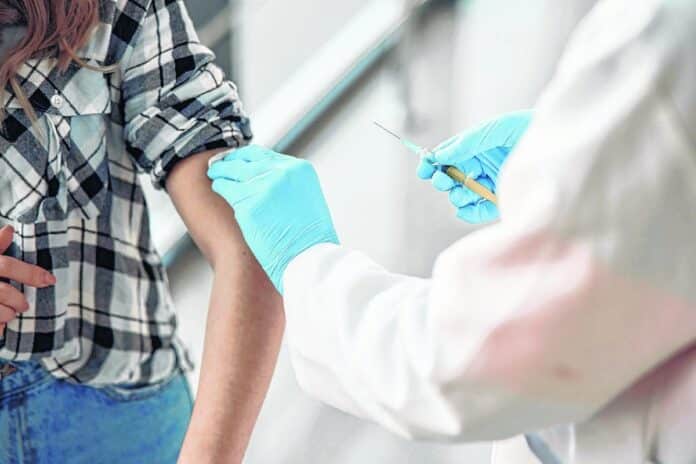
Local health officials are preparing to shift to a more targeted vaccine rollout in the coming weeks as demand continues to decline for COVID-19 vaccines in Bartholomew County and around the U.S.
The local COVID-19 Community Task Force is working on some combined efforts to encourage people to get vaccinated and debunk misinformation about the shots, said spokeswoman Kelsey DeClue.
Local officials also are working to identify some advocates and well-known people in the community to advocate for the vaccine, though no details are currently available on who those people would be or how they would promote the vaccinations.
Right now, communication and coordination is the main objective of the task force, particularly involving the mass Johnson & Johnson vaccine clinic at the Bartholomew County 4-H Fairground on May 25 and 26, DeClue said.
“(We’re) making sure that we get the word out and make connections to all various task force member organizations so that they can reach their audiences,” DeClue said. “We’re also working on pushing information from (Columbus Regional Health) and the CDC, (state health department), etc. with more vaccine information and guidance, some of which aims to debunk and/or correct myths and misunderstandings.”
The planning comes as local officials anticipate a drop in local demand for vaccines in the coming weeks and just days after state health officials confirmed that COVID-19 variants — many of which are more contagious and potentially more virulent — have been detected locally.
Some potential signs of vaccine hesitancy have started to emerge locally despite just 29% of Bartholomew County residents being fully vaccinated as of Friday morning.
A total of 454 fewer Bartholomew County residents received their first dose of a COVID-19 vaccine last week, compared to the week before, according to the Indiana State Department of Health.
That trend is on pace to continue this week, with 573 fewer first doses given to Bartholomew County residents from Monday to Thursday, compared to the same period last week.
Less than 2% of vaccine doses administered since April 11 were the single-shot Johnson & Johnson vaccine.
Similar trends are being seen in Jennings and Jackson counties.
In Jennings County, first doses fell 43% last week, compared to the week before. This week, first doses there were on pace to be down another 32%.
In Jackson County, the number of first doses administered last week fell to 720, down from 739 the week before. But first doses administered fell nearly 32% during the first five days of this week, compared to the same period last week.
Earlier this month, the Jackson County Health Department decided to move a mass vaccination clinic from Seymour High School to the health department’s office because demand was much lower than anticipated, said Lynn Montgomery, the department’s public health coordinator.
“We were prepared to administer 700 doses, but the response was not what we anticipated, and so we ended up doing less than 100,” Montgomery said.
A mass vaccination clinic held around the same time at the Bartholomew County 4-H Fairgrounds fared much better, but still gave out 376 fewer shots than the 1,300 doses that officials had said they were prepared to administer.
The Bartholomew County Health Department is seeing some vaccine appointments go unfilled or people not show up, said Amanda Organist, the department’s nursing director.
On Monday, Columbus Regional Health officials said they were anticipating a drop-off in local demand for the vaccines by mid-May.
“Now we have less and less people just kind of lining up at the vaccine clinic, and so, in some ways, it was more of a passive process where we open the vaccine clinic and (people) come to us,” said Dr. Raymond Lee Kiser, medical director of hospital care physicians at CRH. “I think we’re going to have to shift our focus, and it’s going to be more of an active process.”
That focus, Kiser said, may need to include one-on-one discussions with patients when they go to the doctor.
Among the biggest challenges to boosting demand for the vaccine include clearing up misinformation about the shots, assuaging concerns about potential but rare side effects, a false sense of security many people have about declining hospitalizations and young people underestimating their risk, local officials said.
CRH officials are still seeing younger people with COVID-19 get admitted to the hospital, some with “truly awful” infections, Kiser said.
Over the course of the pandemic, there have been 64 people in their 30s hospitalized with COVID-19 at CRH, resulting in one death, according to hospital records.
Additionally, there have been 25 people in their 20s hospitalized as well as seven people age 18 or younger, though no deaths were reported in those two age groups.
Death, however, is not the only potential consequence of COVID-19, Kiser said.
For significant numbers of people, COVID-19 symptoms can linger for months, including fatigue, cough, shortness of breath, pain, nerve damage, altered sense of taste and smell, depression, as well as inflammation of several vital organs — including the lungs, kidneys, heart and brain.
It is not clear why some patients keep suffering symptoms while others do not.
“If we look at those who have severe enough disease to end up in the hospital, at two months after discharge from the hospital, two-thirds of those patients will still have symptoms,” Kiser said. “So 80% would have fatigue. There’s another significant percent that have a cough or shortness of breath. Even the taste and smell disturbance may last a long time. Even in patients who were not sick enough to come to the hospital, just the mild disease, when they followed up with them at 30 days, it’s still about a third of them who have these symptoms.”
The loss of the sense of smell is particularly concerning feature of the disease, Kiser said.
“I think what people don’t understand is that it’s not affecting your nose,” Kiser said. “That’s not the problem. It’s either affecting the nerve that helps you smell that goes to your brain, or it’s affecting that part of your brain.”
Currently, the race is on to vaccinate as many people as possible as COVID-19 mutations spread and mask and social distancing rules are relaxed.
Now that anyone age 16 and up is eligible for COVID-19 vaccines in Indiana, local health officials worry that younger people who may be at a lower risk of severe illness may opt not to get vaccinated and continue spreading the virus.
That in turn, health officials say, could increase the likelihood that the virus mutates in such a way that it is resistant to the vaccines.
“In truth, it really is a matter of time,” Kiser said. “It’s not if, it’s when it will be able to mutate to escape our current medications and our current vaccines. …If we as a nation decide we are not going to enforce vaccination, then I think we as a nation have made a decision, whether it’s consciously or not, that we are willing to accept the spread of variants, and we will have to deal with those consequences.”
[sc:pullout-title pullout-title=”Where to learn more” ][sc:pullout-text-begin]
To learn more about COVID-19 vaccines, visit https://www.cdc.gov/vaccines/index.html.
[sc:pullout-text-end]




